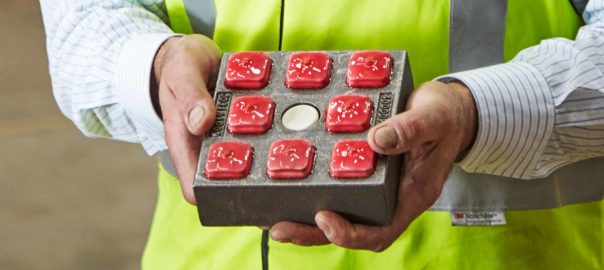FLSmidth’s FerroCer® Impact wear panels have proven their worth in the mineral processing circuit at Hindustan Zinc’s Rampura Agucha operations in Rajasthan, India, having significantly outlasted the previous manganese liners the lead-zinc mine was using.
By the end of 2018, the mine couldn’t say exactly just how good FerroCer wear panels were as they were still in place over a year since installation.
However, by March 2019, it was confirmed the FerroCer liners had completed about 480 days (16 months approximately) in operation and had withstood some 2.45 Mt of lead-zinc ore conveyed through the U-13 tripper chute, located after the primary crusher at the mine.
This is a significant improvement on the previous 40 mm-thick manganese steel liners, which had a life span of only 23-25 days, according to FLSmidth.
The constant wear on these liners meant the material handling system needed to be frequently shutdown so the worn-out liners could be replaced with new manganese steel liners, which weighed about 50 kg each.
“Because of the elevated location of several chutes, replacement of the liners required safety preparations (such as scaffolding and other access and handling arrangements), with five to six workers required to get inside the chutes to handle the liners,” FLSmidth said.
FLSmidth visited officials at the Rampura Agucha mines in June 2017 and recommended FerroCer wear panels to address the high wear issues in the material handling chutes.
“Each panel comprises a set of abrasion-resistant ceramic inserts enclosed in a matrix of malleable steel, which ensures only the top surface of the insert is exposed to material impact,” FLSmidth said. “The sides of the inserts are tapered within the matrix, keeping them in place and preventing material particles and fluids from damaging the panels.”
Some in-situ results from the 220-day mark showed the wear on the panels measured only 8-10 mm and had withstood around 1.5 Mt of lead-zinc ore conveyed through the U-13 tripper chute.
“This means FerroCer outlasted the previous panels by over 10 times, meaning a much longer replacement cycle,” FLSmidth said.
Clearly delighted with this outcome, Hindustan Zinc is now looking to use FerroCer impact wear panels across its high-impact wear locations, according to FLSmidth.
Praveen Bhardwaj, Assistant General Manager (Mechanical), HZL – RA Mines, Rajasthan, said: “FerroCer has reduced maintenance time due to the much longer replacement cycle, eliminated possible damage to the mother plate and spillage of material due to the highly abrasive nature of ore, and significantly reduced safety hazards. HZL intends to install FerroCer impact wear panels in all the high impact wear locations.”
The results at the Hindustan Zinc site follow on from results from two mines in Australia. One mine operated for more than a year without replacing its wear liners and the other site is on the same track, approaching its first year without the need for liner replacement.
Meanwhile, in a Peruvian copper mine, 24 smaller and lighter FerroCer panels, each made of steel plates with ceramic inserts, replaced six generic liners. After a total of 12.6 Mt passed, with a feed of 7,500 t/h, wear was no more than 3%, FLSmidth said.
“At that rate, FerroCer lasts at least 10 times longer than the most expensive and recognised wear liner on the market.”








